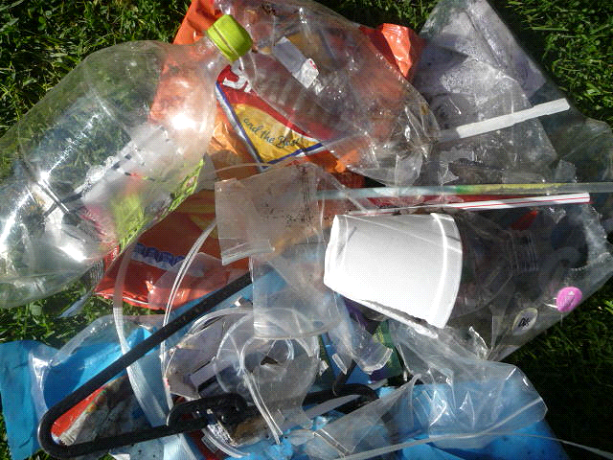Bioplastics are trash says Eunomia report |
Posted on April 16, 2024 by DrRossH in BioPlastics, Plastic Recycling
A recent report that appeared under the title ‘Bioplastics Are Trash: the unforeseen environmental consequences of PLA from production to disposal’ and that was compiled by the North American branch of the international consultancy firm Eunomia, purported to explore the sustainability of one of the more commonly used bio-based plastics today: PLA.
Source: Bioplastics are trash says Eunomia report | Sustainable Plastics
‘Plastic pollution is widely recognised as a threat to human and planetary health’, the report states. This recognition is ‘creating a market for alternative materials such as bio-plastics which are made to look, feel, and perform like conventional plastics, but are derived from non-fossil-based feedstock’, and this report aims to assess the ‘extent to which PLA is a sustainable alternative to conventional, fossil-based single-use plastics’.
Commissioned by the Plastic Pollution Council, the report’s findings make interesting reading. Its overall conclusions, in particular, give pause for thought.
“In the early years, for NatureWorks, using these crops was a big question and a big concern,” said Ford. “However, work published by EuBP and the Institute for Bioplastics and Biocomposites has demonstrated that currently, some 96 percent of the global agricultural area is used to grow food and feed or used as pastures. The area needed to grow biomass for material use accounts for approximately 2 percent. Within this share, bioplastics account for just 0.03 percent – a mere sliver.”
Moreover, she pointed to the fact that in the US, most of the corn that is grown is not used for food. It is industrial corn of which the proteins go to livestock feed, the oil is used as corn oil for a variety of food ingredients and the starches for everything from making paper adhesives, batteries to high fructose corn syrup to PLA. “Every acre is highly productive for downstream markets. It is one of the main benefits to corn,” she emphasised.
Moreover, she said, the report goes on to state that ‘context-specific LCAs are required to determine PLA’s impact relative to fossil-based plastics’ – without mentioning that this data is already available. Both NatureWorks and TotalEnergies Corbion, another PLA manufacturer, have compiled extensive eco-profiles that, said Ford, ‘are some of the most specific ones that exist’. There are no specific LCAs or eco profiles like that for other plastics, Ford pointed out.
“And both come out with similar carbon footprints, which is really interesting. Given that they’re very different feedstocks in very different countries, we still came to roughly the same carbon footprint.”
The Eunomia report goes on to claim that ‘PLA cannot be easily recycled along with conventional plastics, which can lead to contamination given PLA can be confused with conventional plastics by consumers when sorting their recycling’. What it fails to mention is that PLA is readily sortable using industrial standard near infrared sorting technologies. Purities of 97% have been obtained – a percentage higher than most traditional plastics. Furthermore, studies have shown that PLA does not contaminate the traditional plastic recycle stream any more than other traditional plastics; in fact, adding 10% PLA into polyolefin recycling streams has the same impact on the material properties as adding 10% PET or PS to these streams. ‘PLA bioplastics can be mechanically and chemically recycled and there are no technical barriers to doing so’ states a whitepaper compiled by TotalEnergies Corbion.
“Recycling can really work beautifully,” agreed Ford. “ We’ve done it in multiple closed loop venues – music festivals and the like – in both the US and in Europe, where we’ve collected all the cups and sent them either to mechanical recycling or even chemical recycling to recapture the lactic acid. Both are very doable in a closed loop setting.”
She also noted that the current debate about the recycling versus composting of PLA was not about the ‘best’ end of life option, but about the most sustainable option in any specific case.
“This [report] felt like it was trying to take a little position on shaping that debate. But we can’t be in this market if we aren’t trying to hit really high sustainability goals and be able to answer questions like the ones raised here. Because brands won’t take that risk. They too have a responsibility and must report on their material choices. We’ve learned a lot in the time since we started manufacturing this material, and we know the sustainability credentials we need to get.”
It would therefore seem that, while the ‘Bioplastics are trash’ report does explore the sustainability of PLA in some detail, it fails to tell the whole story. The reason can perhaps be found in the final paragraph of the report’s conclusion.
‘Current solutions to plastic and bioplastic waste focus on recovery and recycling. However, the principles of the waste hierarchy should lead to the prioritisation of reduce and reuse’, the authors write.
There is no doubt that reduce and reuse play a major role in plastic waste management. But that alone will not be enough to solve the plastic waste crisis currently confronting the planet. In that light, it is worthwhile evaluating all the options – openly and evenhandedly.
Different materials have different end-of-life disposal options and these can even vary per application. Just as reduce and reuse, recycling, recovery and even compostability may all be considered key components in the efforts to tackle plastic waste.
Bioplastics do end up as trash, as do so many other kinds of plastic. The point is, of course, what is the most sustainable way to handle these materials at the end of life?
According to this report, the sustainability of PLA ‘is conditional on the development of appropriate policies and regulations to minimise or eliminate unintended and negative production consequences, alongside comprehensive waste management strategies and large-scale infrastructure investments’.

 How many people today grab a takeaway coffee cup from the local cafe to drink on the go? We don’t know, but the number must be enormous.. Most every one of the above have a plastic top that will last 100s of years. Some cafes still use plastic cups that last a similar time. Is 10 minutes of coffee worth 100s of years of trash?
These items can be seen littering our gutters and on our streets all over the place. If they were all cardboard, they would still be littered, but they would, at least, be gone in a short time.
They do not need to be made of plastic.
How many people today grab a takeaway coffee cup from the local cafe to drink on the go? We don’t know, but the number must be enormous.. Most every one of the above have a plastic top that will last 100s of years. Some cafes still use plastic cups that last a similar time. Is 10 minutes of coffee worth 100s of years of trash?
These items can be seen littering our gutters and on our streets all over the place. If they were all cardboard, they would still be littered, but they would, at least, be gone in a short time.
They do not need to be made of plastic.
 On the way home from the gym last week, a distance of about 1 km (1/2 mile), I counted the items of plastic litter on the curb as I walked. In that short distance I counted 63 pieces of plastic litter. Plastic drink bottles, bottle tops, candy wrappers, plastic film, polystyrene fragments etc. That seemed to be a lot to me. I guess it is a generational thing. Our parents would have been horrified to see that amount, whereas it seems to go unnoticed by our youth of today. In another 20 years how many pieces will there be on this stretch, -- 200? What will today’s youth think of that new amount then when they are older? Will their children be so readily accepting of a higher amount of litter?
On the way home from the gym last week, a distance of about 1 km (1/2 mile), I counted the items of plastic litter on the curb as I walked. In that short distance I counted 63 pieces of plastic litter. Plastic drink bottles, bottle tops, candy wrappers, plastic film, polystyrene fragments etc. That seemed to be a lot to me. I guess it is a generational thing. Our parents would have been horrified to see that amount, whereas it seems to go unnoticed by our youth of today. In another 20 years how many pieces will there be on this stretch, -- 200? What will today’s youth think of that new amount then when they are older? Will their children be so readily accepting of a higher amount of litter?
Discussion · No Comments
There are no responses to "Bioplastics are trash says Eunomia report | ". Comments are closed for this post.Oops! Sorry, comments are closed at this time. Please try again later.